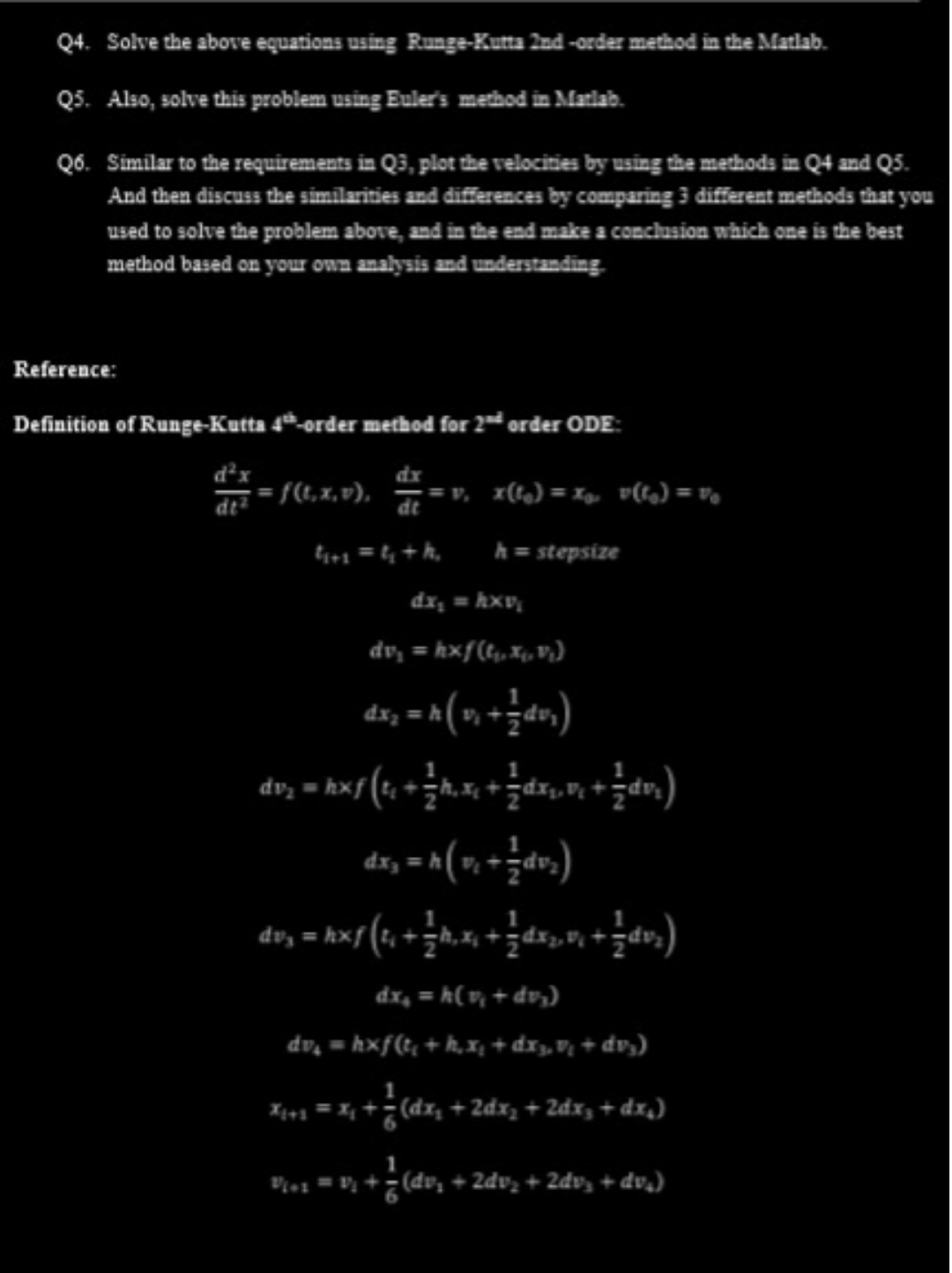ATLAB BUILT CODE REQUEST FOR 4 QUESTION.
Computer Networking: A Top-Down Approach (7th Edition)
7th Edition
ISBN:9780133594140
Author:James Kurose, Keith Ross
Publisher:James Kurose, Keith Ross
Chapter1: Computer Networks And The Internet
Section: Chapter Questions
Problem R1RQ: What is the difference between a host and an end system? List several different types of end...
Related questions
Question
MATLAB BUILT CODE REQUEST FOR 4 QUESTION.

Transcribed Image Text:Q4. Solve the above equations using Runge-Kutta 2nd-order method in the Matlab.
Q5. Also, solve this problem using Euler's method in Matlab.
Q6. Similar to the requirements in Q3, plot the velocities by using the methods in Q4 and Q5.
And then discuss the similarities and differences by comparing 3 different methods that you
used to solve the problem above, and in the end make a conclusion which one is the best
method based on your own analysis and understanding.
Reference:
Definition of Runge-Kutta 4-order method for 2nd order ODE:
dx
dt
d²x
dt² =f(t, x, v),
=v, x(₂)=xo. v(1₂) = Vo
²₁+₁=4₁+h₂
h = stepsize
dx₂ = hxv₂
dv₂ = kxf (₁,₁,₂)
_dx;= h (v₁ + ½dv₁)
dv₂ = kxf (t; + ½h.x; + ½ dx;,v; +{dv₂)
dx₂ = h (v₁ + dv₂)
dv₂ = kxf (t; + ½ h‚x, + ½dx₂,v,+ dv₂)
dx₂ =h(v₁ + dv₂)
dv₂ = hxf(t₁ +h₂x₁ + x₂v₂ + dv₂)
X1+₁ = x₁ + ² (dx₂ + 2dx₂ + 2dx, +dx₂)
= v₁ + ² (dv₂ + 2dv₂ + 2dv¸ + dv₂)
Expert Solution
This question has been solved!
Explore an expertly crafted, step-by-step solution for a thorough understanding of key concepts.
Step by step
Solved in 3 steps with 1 images

Recommended textbooks for you

Computer Networking: A Top-Down Approach (7th Edi…
Computer Engineering
ISBN:
9780133594140
Author:
James Kurose, Keith Ross
Publisher:
PEARSON

Computer Organization and Design MIPS Edition, Fi…
Computer Engineering
ISBN:
9780124077263
Author:
David A. Patterson, John L. Hennessy
Publisher:
Elsevier Science

Network+ Guide to Networks (MindTap Course List)
Computer Engineering
ISBN:
9781337569330
Author:
Jill West, Tamara Dean, Jean Andrews
Publisher:
Cengage Learning

Computer Networking: A Top-Down Approach (7th Edi…
Computer Engineering
ISBN:
9780133594140
Author:
James Kurose, Keith Ross
Publisher:
PEARSON

Computer Organization and Design MIPS Edition, Fi…
Computer Engineering
ISBN:
9780124077263
Author:
David A. Patterson, John L. Hennessy
Publisher:
Elsevier Science

Network+ Guide to Networks (MindTap Course List)
Computer Engineering
ISBN:
9781337569330
Author:
Jill West, Tamara Dean, Jean Andrews
Publisher:
Cengage Learning

Concepts of Database Management
Computer Engineering
ISBN:
9781337093422
Author:
Joy L. Starks, Philip J. Pratt, Mary Z. Last
Publisher:
Cengage Learning

Prelude to Programming
Computer Engineering
ISBN:
9780133750423
Author:
VENIT, Stewart
Publisher:
Pearson Education

Sc Business Data Communications and Networking, T…
Computer Engineering
ISBN:
9781119368830
Author:
FITZGERALD
Publisher:
WILEY